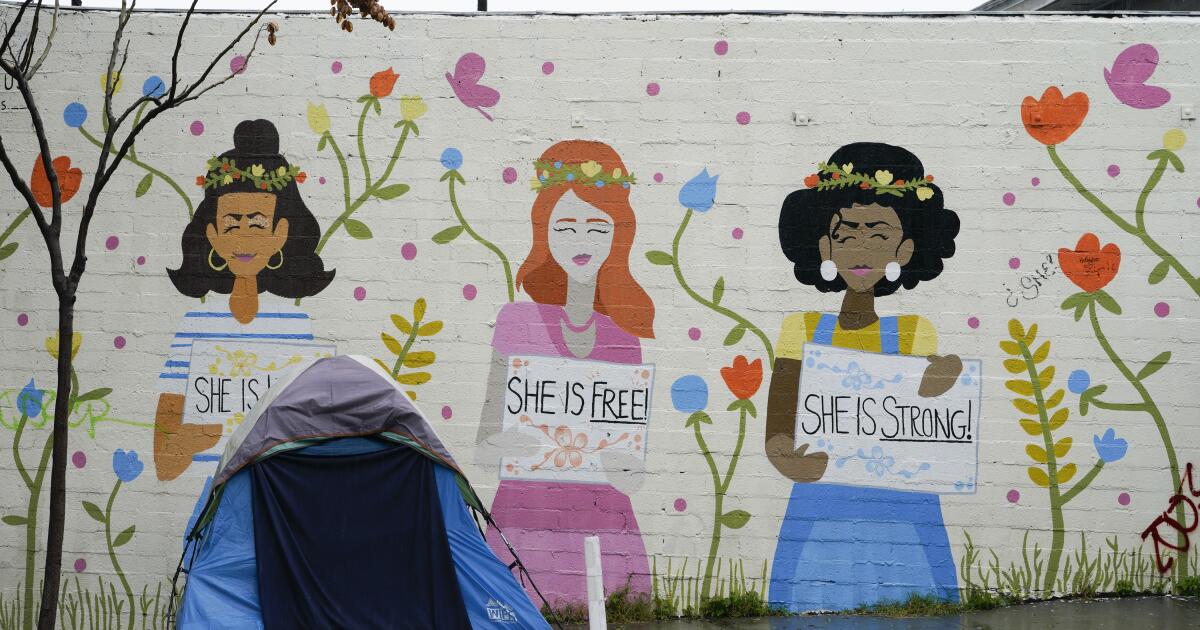

San Diego city officials spent hundreds of millions of dollars over three years to fight a growing homelessness crisis but failed to fully report its revenue and spending — or even evaluate the effectiveness of many programs, a state audit released Tuesday says.
During the three fiscal years between July 2020 and June 2023, San Diego spent more than $218 million from federal, state and local sources on a myriad of programs.
But San Diego officials did not clearly define performance measures related to much of that spending or make sure that service providers properly outcomes for the work they were paid to perform, state auditors said.
“For example, in a $1.6 million agreement for interim housing and supportive services, the housing commission did not specify how many people the provider should serve or set a target for occupancy,” the report said.
“Housing commission staff explained that attaching goals to certain metrics can create unintended adverse behaviors from service providers to meet those goals,” it added.
The California State Auditor’s report examined homelessness spending in the cities of San Diego and San Jose. It found similar deficiencies in spending and reporting practices in San Jose, which expended more than $300 million over the same three-year period.
“Both cities use interim housing as a way to provide shelter for people experiencing homelessness, but they both need to develop additional permanent housing,” state auditor Grant Parks wrote.
“Data consistently show that placements into permanent housing results in significantly better outcomes than placements into interim housing,” Parks added.
San Diego officials generally agreed with recommendations from the state auditor and indicated they would take steps to implement them where feasible.
The San Diego Housing Commission, a separate agency that operates under the city housing authority made up of the nine city council members, disagreed with several of the auditor’s findings and conclusions.
The audit examining homelessness spending in San Diego and San Jose was released in conjunction with another report evaluating efforts to fight homelessness across the state.
That report notes that more than 180,000 people in California experienced homelessness in 2023 — up 53 percent from one decade earlier. Nine state agencies invested billions of dollars over the past five years without consistently tracking or evaluating the spending.
The number of unhoused people has climbed in San Diego in recent years, the audit found, but not as steeply as statewide.
Between 2015 and 2023, the audit said the number of people in San Diego experiencing homelessness rose from 5,538 to 6,500, based on the city’s point-in-time counts — an increase of just over 17 percent. Over the same period, the number of unhoused people in San Jose jumped up by 56 percent.
The findings may be especially significant because both San Diego and San Jose have huge chunks of homelessness funding they have yet to expend.
According to the state review, San Diego was sitting on more than $52 million in unspent state and federal funds. Most of that came from $21 million in state Homeless Housing Assistance and Prevention grants and $22 million earmarked under a permanent housing program.
San Jose was holding more than $86 million in unallocated money designated for homelessness programs, the audit said.
“To inform decision-makers and provide transparency, the cities should track and report in a single location all funding they receive and use to reduce homelessness,” state auditors wrote in their recommendations.
The report gave credit to both cities for adopting specific plans to address the rising homelessness in their jurisdictions. But the audit said each city could improve how it reports on its objectives and outcomes.
“Neither San Jose nor San Diego has measured the effectiveness of all of its programs to address the risks of unsheltered homelessness,” the report said.
The audit also said neither city “has a clear, long-term plan for meeting its need for permanent supportive housing.”
Specifically, auditors reviewed 14 separate programs run by each of the two cities.
San Jose failed to set clearly defined goals in any of the 14 agreements reviewed by auditors. San Diego enacted specific performance measures in eight of the 14 projects reviewed; the other projects had undefined goals or no goals at all.
“Although both cities asserted that they monitored or reviewed the performance of their service providers, their staff did not always document overall conclusions about the effectiveness of the service providers’ efforts,” auditors wrote.
“One reason for this gap is that the cities’ procedures do not require staff to formally document such assessments,” they added.
The audit was released five days after San Diego Mayor Todd Gloria introduced a new shelter plan in the Middletown neighborhood just north of Little Italy. That plan, which lacks details and has yet to be approved by the City Council, would add 1,000 or more shelter beds.
It also comes as the city confronts a budget deficit of more than $160 million for the fiscal year that begins July 1.
Even so, San Diego increased its health and safety program spending during the three years studied by auditors, from $32.3 million in the year ending June 30, 2021, to $42.9 million in the year ending June 30, 2023.
That money paid for things like sidewalk cleaning, day centers, outreach work and designated camping and parking site programs.
“Although the city tracked these data and set some expectations around the frequency with which Clean SD would provide services, it did not develop performance measures for evaluating the program’s effectiveness, such as a reduction in public health incidents arising from encampments,” the report said.
Both cities also need to do a better job moving people into permanent housing, the state review said. In each jurisdiction, more than 85 percent of those placed into housing went into temporary housing.
“Additionally, the placements within a city are not necessarily the direct responsibility of that city’s government,” the audit found.
In each city, people of color are overrepresented among the population of unsheltered people.
San Diego, for example, Black people account for almost 25 percent of the unsheltered population, or 4.5 times their number among the overall population, the audit said. Indigenous people make up a similarly disproportionate part of the homeless population.
The audit said both cities should ensure that they establish clearly defined performance measures when entering new agreements with service providers. The cities should also require annual documentation for performance and effectiveness, it said.
In response to the audit, city officials generally agreed with the state findings but said they already comply with much of what the audit recommends.
“The city already has existing spending plans already in place, but will publicly report them in a single location,” Chief Operating Officer Eric Dargan wrote. “The city already requires performance measures, and an overall review and assessment of the effectiveness of service providers is in progress.”
Dargan recently told The San Diego Union-Tribune he aims to eliminate the city’s homeless services department and rely more heavily on private philanthropy to address homelessness.
The housing commission issued a response that was more critical of the audit findings.
Commission President Lisa Jones said the agency has already launched a series of programs with high impact and regularly exercises and upgrades its various monitoring tools.
“It is unfortunate that the audit report’s discussion of SDHC and its efforts was too narrowly focused, did not reflect understanding of the breadth of SDHC’s extensive efforts and lacked the context necessary for a comprehensive assessment of the homeless shelters and services system,” Jones wrote.
The auditor’s response said the office stands by its findings.






